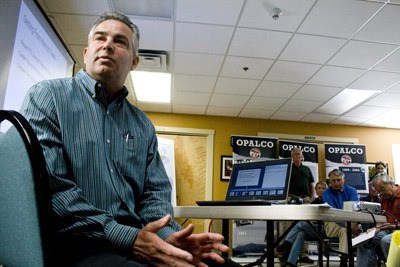The Orcas senior center was overflowing with islanders – some were men, others were women, several spoke out numerous times, while the rest quietly listened. What they had in common was their support for Orcas Power and Light Cooperative’s Broadband Initiative, which they showed by raising their hands.
“What we’re really looking for is feedback,” said Suzanne Olson, communication specialist for OPALCO. “So far we’ve had a lot of positive feedback.”
During similar meetings hosted by OPALCO and the Economic Development Council on Lopez and San Juan Island, reactions to the initiative have been mixed.
Three years ago, the San Juan County Economic Development Council and the San Juan Island Community Foundation took on the task of researching what improved broadband speeds could do for the economy and community. An OPALCO member survey in the fall of 2011 showed broad support, and detailed studies are under way to determine the feasibility and potential business models for expanding the service. OPALCO is currently cooperating with a county-wide effort to expand broadband access to members – reaching up to 90 percent of San Juan County with a minimum speed of 10 megabytes per second.
The series of broadband – high-speed Internet and other communication services – meetings across the islands were held to discuss what services would be provided and when, the costs and the provider. While many of those answers are still under consideration, OPALCO’s staff had one question ready to answer: why broadband would benefit the islands. According to OPALCO, broadband would provide electric system reliability and Smart Grid technology that delivers tools for members to monitor and control their own energy usage and therefore their costs. It would also improve public safety communication, education and economic development.
Infrastructure is projected to cost $16 to 18 million assuming OPALCO can secure a low interest loan for co-ops from the government. All OPALCO members would be charged $5 to 10 a month, whether they use the service or not. Subscribers would also pay an additional monthly fee comparable to the cost of existing broadband service from current Internet service providers and possibly $40 to $50 for a subscription.
“We want to be very transparent about our costs,” said J. Foster Hildreth, OPALCO’s assistant general manager. “We’re very sensitive to island aesthetics and environment. I can’t stress that enough.”
OPALCO has fiber-optic “trunk” lines, mainly running underground the islands, in its service territory of San Juan, Orcas, Lopez, Shaw, Decatur and Blakely. Fiber-optic lines are strands of optically pure glass that carry digital information over long distances. The fiber network needs to be expanded and poles installed to carry the wireless signal between islands, according to OPALCO.
About 75 percent of the poles are projected to be 65 feet high, while the remaining would be about 150 feet.
At the Lopez meeting, islanders expressed health concerns about possible radiation from radio frequency, which is the mode of communication for wireless technology.
Islanders voiced their support for broadband, if the underground fiber-optic lines could come directly to their homes, but not for the poles or possible radiation.
According to OPALCO, only implementing fiber-optics would be too expensive – requiring an investment of $60 to 70 million.
“We want fiber to go where it can,” said Vince Dauciunas, who serves on OPALCO’s board of directors.
A few Lopezian telecommuters and small business owners expressed their support for the initiative.
One business owner said she supported OPALCO’s plan because her work suffered from slow internet speed, and the boost for life-saving emergency communications in areas that are currently “radio blind spots” is crucial.
Randy Lindsey, owner of Windjammer Communications, which provides cable and satellite internet services, said he is concerned about the future of local Internet service providers.
“We have been in business for 28 years,” Lindsey said. “This plan will surely put us and other local ISPs [providers of email and web-hosting services] under.”
On San Juan Island, supporters outnumbered skeptics, but Rick Boucher of Orcas Online might have been speaking for both sides when he said, “There are just so many unknowns that need to be resolved.”
Hildreth and Dauciunas answered that much more information would be forthcoming, and many more meetings would be held as the initiative moves forward.
There are still a few important items they must check off their lists before the initiative comes close to becoming a reality: securing the FCC licensed frequency spectrum, confirming the county permitting process and completing technical and business due diligence, according to Hildreth.
“I think we can achieve this vision,” Hildreth said. “We can do this and benefit the community. It’s consistent with OPALCO’s mission.”
The final decision will be left up to OPALCO’s board of directors.
As San Juan Islanders filed out of their meeting, Boucher of Orcas Online expressed misgivings about OPALCO’s motivations, but confidence in his own company’s future.
“We’ll make lemonade out of these lemons,” he said.
– Chom Greacen, freelancer for the Weekly, and Steve Wehrly, reporter for the Journal, contributed to this article.




